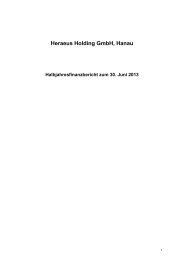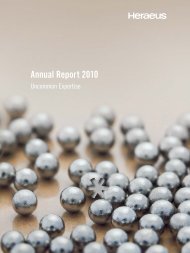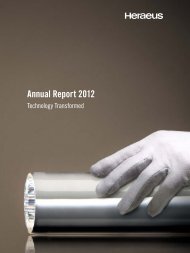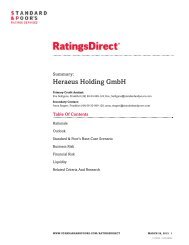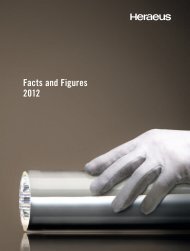english - About Heraeus
english - About Heraeus
english - About Heraeus
Create successful ePaper yourself
Turn your PDF publications into a flip-book with our unique Google optimized e-Paper software.
(27)<br />
Free cash flow<br />
Free cash flow includes all cash flows from operating activities as well as investing activities<br />
performed in connection with operating business. Not included in free cash flow<br />
are pure financial investments and similar monetary deposits of more than three months,<br />
which are also to be reported as cash flows from investing activities under IFRS.<br />
FinanCial Risk manaGement and HedGe aCCoUntinG<br />
In connection with its operating activities and in financing, the <strong>Heraeus</strong> Group is particularly<br />
exposed to interest rate, currency, price, default, and liquidity risks. Both the Group’s<br />
risk management system and its financial management system are responsible for measuring,<br />
controlling, and monitoring these risks.<br />
Corporate Treasury and Precious Metal Trading are responsible for limiting the risks<br />
explained in greater detail below by entering into hedging transactions, if appropriate.<br />
The use of these hedging trans actions is subject to clear, Group-wide guidelines, the<br />
content of which is constantly monitored and adapted as needed. <strong>Heraeus</strong> is not exposed<br />
to any significant risk concentrations from financial transactions.<br />
Interest rate risk<br />
An interest rate risk is present when interest rate changes have a negative impact on the<br />
assets and earnings position of the <strong>Heraeus</strong> Group. The priority is primarily on avoidance<br />
of interest rate risks; however, advantage is also taken of the income potentials of interest<br />
rate changes. The long-term financing of the Group rests primarily on the issue of promissory<br />
notes, a bond, and a privately placed promissory note. Interest derivatives derived<br />
from the underlying transactions are used to support interest rate management. When<br />
using derivatives, customary instruments are used. These include interest rate swaps and<br />
interest options for the stipulation of upper and lower interest limits (caps, floors, collars).<br />
65




